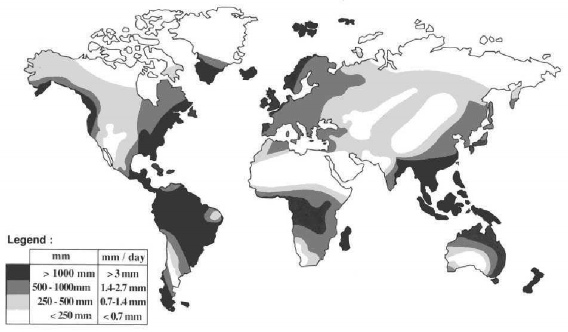20. Distribution of Precipitation

The mean annual rainfall on Earth is about 100 cm but different places on the earth’s surface receive different amounts of rainfall in a year and that too in different seasons. Factors controlling the distribution of rainfall over the earth's surface are the belts of converging- ascending air flow (doldrums; polar front etc.), air temperature, moisture-bearing winds, ocean currents, distance inland from the coast, and mountain ranges. In general, as we proceed from the equator towards the poles, rainfall goes on decreasing steadily. The coastal areas of the world receive greater amounts of rainfall than the interior of the continents. The rainfall is more over the oceans than on the landmasses of the world because of being great sources of water. Between the latitudes 350 and 400 N and S of the equator, the rain is heavier on the eastern coasts and goes on decreasing towards the west. But, between 450 and 650 N and S of equator, due to the westerlies, the rainfall is first received on the western margins of the continents and it goes on decreasing towards the east. Wherever mountains run parallel to the coast, the rain is greater on the coastal plain, on the windward side and it decreases towards the leeward side.
On the basis of the total amount of annual precipitation, major precipitation regimes of the world are identified as follows.
Areas of Heavy Rainfall: The regions receiving more than 200 cm of annual precipitation are included in this belt. The main areas are the equatorial belt, the mountain slopes along the western coasts in the cool temperate zone and the coastal areas of the monsoon lands.
Areas of Moderate Rainfall: The regions receiving 100 cm to 200 cm of annual precipitation are included in this belt. The main areas lie adjacent to the regions of heavy rainfall. The coastal areas in the warm temperate zone also receive moderate precipitation.
Areas of Low Rainfall: The regions receiving 50 cm to 100 cm of annual precipitation are included in this belt. The main areas lie in the central part of the tropical lands and in the eastern and the interior parts of the temperate lands.
Areas of Scanty Rainfall: The regions receiving less than 50 cm of annual precipitation are included in this belt. The main areas are the rain shadow areas on the leeward slopes of the mountain ranges, the interior of the continents, the lands in the high latitudes, western margins of the continents in the tropical areas and the arid deserts.

